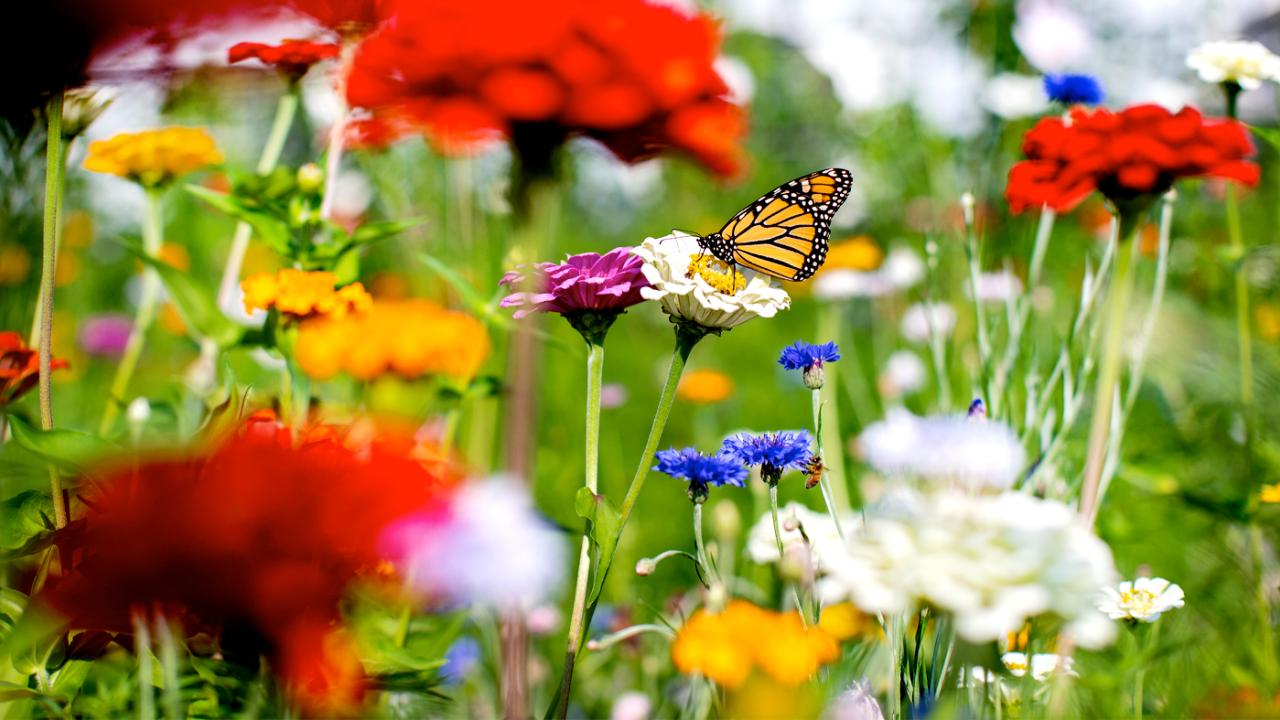

Aster
Aster spp.
Asters are a highlight of the autumn landscape. There are about 250 species native to North America, Europe, and Asia. Illinois native perennial asters grow along roadsides, in woodlands, prairies and other natural areas. As summer wanes, they put on a stellar show of flowers in blue, purple, pink, violet, or white that attract butterflies and other pollinators. Although wild asters have a reputation for looking lanky or weedy rather than bushy and compact, their seeds are an important food source for birds in winter.

Symphyotrichum ‘Bridal Veil’

Symphyotrichum o blongifolium ‘October Skies’
Ornamental Features
A key attractive feature of most asters is the mass of striking flowers that resplendent in the garden and in a vase. Depending on the cultivar, plants may have a low and mounding habit, form compact clumps, or be large and billowy. The new growth on ‘Lady in Black’ calico aster is bronze and stays purple all summer when grown in full sun. ‘Bridal Veil’ aster (Symphyotrichum ‘Bridal Veil’), developed at the Chicago Botanic Garden, has upward-arching stems that develop a graceful weeping habit as the season progresses. Crush the leaves of fragrant or aromatic aster (Symphyotrichum oblongifolium) and you’ll notice a minty aroma. 'October Skies’ aromatic aster was selected for the Chicago Botanic Garden's plantings for its intense lavender-blue flowers.

Learn more about the Garden’s aster evaluation.
Visit the Garden's Dixon Tallgrass Prairie in autumn to view thousands of New England asters in bloom.
Asters have New Names
The word aster comes from the Greek word for star—a nod to the flower’s shape, which has disk and ray florets. The Latin genus name has changed from Aster to tongue twisters such as Doellengeria, Eurybia, and Symphyotrichum—baffling gardeners and professionals alike. Asters are in the daisy (Asteraceae) family. In the 1990s, taxonomists reclassified the names based on new DNA research. For example, the native New England aster, formerly called Aster novae-angliae is now Symphyotrichum novae-angliae, a mouthful to be sure. Calico aster, a Chicago-area native, formerly known as Aster lateriflorus is now Symphyotrichum lateriflorum. It’s taking time for gardeners and the green industry to adjust to the generic name changes.
Cultivation
Asters are easily grown in average, dry to moist, well-drained and moderately fertile soils in full sun to part shade. According to the Garden’s plant evaluation, woodland asters, such as blue wood aster (Symphyotrichum cordifolium), Drummond’s aster (S. drummondii), white wood aster (Eurybia divaricata), and bigleaf aster (E. macrophylla) tolerate deep shade but produce the best flower display with some morning sun. Pinching back the stems (removing a few inches of the top growth) before mid-July promotes bushiness and eliminates the need for staking taller species. Asters are known to prolifically reseed. To avoid an over abundance of asters next year, remove the seed heads before they fall to the ground unless you wish to leave a few stems standing for the birds. Dividing plants every two to three years in spring will help keep them healthy and corral aggressive plants that spread by rhizomes.

White Wood Aster (Eurybia divaricata)

Drummond’s aster (S. drummondii)
Cultivars
Plant breeders have developed many popular aster cultivars suitable for the home landscape. The Garden completed “A Comparative Study of Cultivated Asters,” published in 2013 based on a six-year evaluation of 119 different asters. Some of the highly rated cultivars in the evaluation include ‘Jindai’ Tatarian aster, ‘Snow Flurry’ white heath aster, ‘Raydon’s Favorite’ aromatic aster, ‘Eastern Star’ white wood aster, ‘Kylie’ aster, a hybrid of New England aster and heath aster, and ‘Doktor Otto Petschek’ Italian aster.

'Doktor Otto Petschek' Italian aster

'Snow Flurry' White heath aster
Pests and Diseases
Asters may be affected by verticillium wilt (a fungus in the soil), gray mold, powdery mildew, rusts, white smut, aster yellows, and many fungal leaf spots and stem cankers. They are also prone to rosy blister gall, aphids, mites, slugs and nematodes. Chrysanthemum lace bug is a new pest that sucks nutrients from aster foliage, leaving it mottled and sickly. Rabbits may browse the plants.
Ecological Benefits
Asters provide nectar, pollen and foliage for several native insects. Some of the pollinators and nectar-seekers visiting aster flowers include long- and short-tongued bees, honeybees, bumblebees, bee flies and butterflies. The plant serves as a host for several species of moths. Silvery Checkerspot butterflies lay their eggs on Aromatic Aster (Symphyotrichum oblongifolium), and Pearl Crescent butterflies lay eggs on Big-Leaved Aster (Eurybia macrophylla), both native Illinois asters. Asters also provide nectar for migrating monarch butterflies.
Companion Plants
Asters can be massed together for a show-stopping display in September. The native species work well in naturalized or native gardens. Pair attractive cultivars with other late-blooming perennials such as sedum, heliopsis, helianthus, butterfly bush and ornamental and native grasses such as little bluestem, big bluestem and prairie dropseed.

